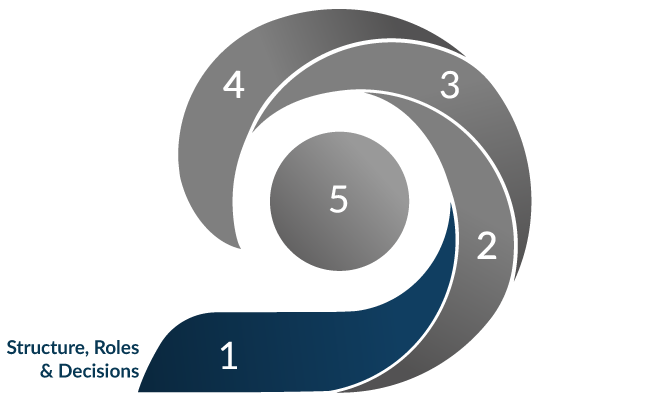
HET® for Strategy Teams
Module 1: Structure, Roles & Decisions
The HET Principles in Module 1 provide a common language to help teams organize for success, even before actual strategic development begins.

The wave graphic illustrates how the modules fit together over the life cycle of a team. Module 1 focuses on Structure, Roles, & Decisions.
Key Principles
Module 1 consists of three key principles:

Organize Your Team, Early
Avoid chaos at the outset with a clear team structure and expectations across your organization to contribute to building a strategy.
Align the structure is the first step toward clarifying roles and decision-making authorities. A typical source of of chaos, conflict, or confusion in teamwork is a lack of clarity on the team structure and how different parts of the organization are expected to contribute to a strategy. This can be especially fraught in organizations practicing matrix-management. The recommended tool for this principle—the HET Family Tree—illustrates the relationships between different parts of the organization leading and contributing to a specific strategy and its nested portfolios of projects. It also clarifies reporting lines for issue escalation and conflict resolution in order to reduce conflict between colleagues with uneven power dynamics.

Define Who’s Doing What
Specify the roles, people, and responsibilities needed to build your strategy and implement the body of work within it.
Balance the roles takes a deeper dive into the necessary roles, possible people, and responsibilities that make up the strategy. While the HET Family Tree shows the people dynamics and interactions outside the strategy, the HET Strategy Team Organizational Chart clarifies the people and roles within the strategy and inside the projects and roles nested within the strategy. HET comes with an experienced point of view on considerations and best practices for structuring strategy teams, with different starting models depending on the maturity level of the strategy and the extent of matrix-management deployed in the organization.

Decide How to Decide
Document a clear decision-making process, roles, and decision-points to improve your team’s performance moving the strategy from start to finish.
Capture decision-making, the third principle in this stage of teamwork, results in a strong starting point for a documented decision-making process and authorities for the strategy. The HET Decisions Map:
- Lays out the major gates that typical projects within a given strategy go through from idea to implementation, evaluation, and scale-up;
- Identifies the go/no-go decisions; and
- Clarifies roles and decision-making authorities for each stage and decision point.
This tool continues to evolve over time as more unanticipated decision points are reached, but having a solid starting point at the outset of the work will make future decision-making more predictable, efficient, transparent, and equitable.

The HET Framework
Module 1: Structure, Roles & Decisions
Module 2: Strategy Articulation & Prioritization
Module 3: Project Planning & Implementation
Module 4: Active Management
Module 5: HET for All
